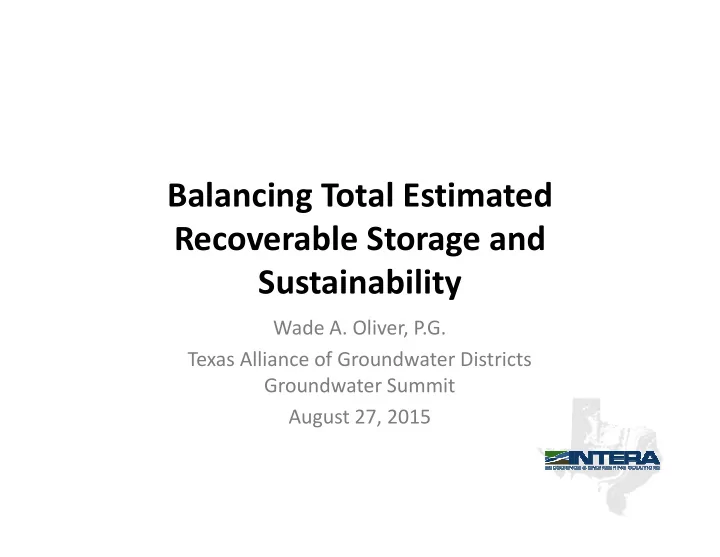

Balancing Total Estimated Recoverable Storage and Sustainability Sustainability Wade A. Oliver, P.G. Texas Alliance of Groundwater Districts Groundwater Summit August 27, 2015
The “9 Factors” Districts Shall Consider When Adopting Desired Future Conditions Paraphrased Factors in Texas Water Code Sec. 36.108(d) : 1. Aquifer uses or conditions… 2. Water supply needs and management strategies… 3. Hydrological conditions, including for each aquifer in the management area the total estimated recoverable storage management area the total estimated recoverable storage as provided by the executive administrator [of TWDB] … 4. Other environmental impacts 5. Impact on subsidence 6. Socioeconomic impacts 7. Impact on private property rights 8. Feasibility of achieving the DFC 9. Any other relevant information
Definitions Total Estimated Recoverable Storage —The estimated amount of groundwater within an aquifer that accounts for recovery scenarios that range between 25% and 75% of the porosity-adjusted aquifer volume Texas Administrative Code Sec. 356.10
Types of Aquifers Unconfined Confined Northwest Northwest Southeast Southeast Measured Water Level
Guidance from TWDB Typical County Example 30 miles x 30 miles 900 square miles 500 feet 15% 576,000 acres
Guidance from TWDB Typical County Example 30 miles x 30 miles 43.2 million 900 square miles 500 feet 15% = 576,000 acres acre-feet
Guidance from TWDB Typical County Example 30 miles x 30 miles 43.2 million 900 square miles 500 feet 0.15 = 576,000 acres acre-feet 500 feet 0.03 million 0.0001 = acre-feet Unconfined Portion: Confined Portion: Specific Yield Storativity
MAGs and Storage by GMA Total Estimated Total MAG over Storage MAG in 2060 50 Years Total MAG as GMA (million acre-feet) (million acre-feet) (million acre-feet) Percent of Storage 1 588 2.27 150 25.0% 2 968 1.344 94 9.7% 3 476 0.461 23 4.8% 4 160 0.207 10 6.3% 5 NA NA NA NA 6 180 0.422 22 12.2% 7 7 447 447 0.648 0.648 33 33 7.4% 7.4% 8 1,628 0.386 19 1.2% 9 33 0.096 5 15.2% 10 46 0.1 5 10.9% 11 2,488 0.543 27 1.1% 12 1,380 0.337 15 1.1% 13 2,756 0.485 24 0.9% 14 3,085 0.907 47 1.5% 15 443 0.488 24 6.0% 16 2,205 0.358 18 0.8% Total 16,883 9.052 516 3.1%
Implications Water demand in Texas – 20 million acre-feet between 2020 and 2070 – At 25% recoverability, do we have enough groundwater to meet all demands for 200 years even if it doesn’t rain again? – “If it sounds too good to be true…” No consideration given to: No consideration given to: – Aquifer water quality – Water levels dropping below pumps – Land surface subsidence – Degradation of water quality – Changes to surface water-groundwater interaction – Recharge – Practicality/economics of development
Unconfined vs. Confined Storage > Specific Yield Storativity Takeaway: In theory, each foot of drawdown yields much more water when an aquifer is unconfined than when it is confined. From Heath (1983)
Aquifer Lithology
Drawdown vs. Storage Volume in an Example Confined Aquifer Exact shape of curve is aquifer specific and depends on initial water levels, aquifer thickness, and storage properties (storativity and specific yield). Idealized curve developed using a 500 ft thick aquifer with 500 feet of confined head. Storativity set to 0.0001 and specific yield (Sy) is varied.
Balancing Test Paraphrased Factors in Texas Water Code Sec. 36.108(d-2) : “The desired future condition proposed under Subsection (d) must provide a balance between the highest practicable level of groundwater production and the conservation, preservation, protection, recharging, and prevention of waste of groundwater protection, recharging, and prevention of waste of groundwater and control of subsidence in the management area”
Balancing Test Less More Pumping Pumping Conservation, Highest Total Preservation, etc. Practicable Estimated Recoverable Storage Storage Modeled Available Groundwater Must Fall in this Range Total Highest Estimated Practicable Recoverable Storage
Balancing Test Total Estimated Conservation, Recoverable Highest Preservation, etc. Storage Practicable Aquifer uses or Environmental conditions Impacts Water supply needs and Water supply needs and Subsidence Subsidence management strategies Impacts Socioeconomic Socioeconomic Impacts Impacts Feasibility of Private Property achievement Rights Private Property Hydrological Rights Conditions Hydrological Conditions
In Conclusion • As calculated, TERS represents the approximate fraction of total storage in the aquifer that is in the water-producing zones (e.g. sands), not what is “recoverable”. • TERS is a simple volumetric calculation that does not account for many important factors that limit not account for many important factors that limit groundwater production • With few exceptions, TERS is far greater than the highest practicable level of groundwater production and is not a useful tool for the planning and management of aquifers.
Contact: Wade A. Oliver, P.G. INTERA Inc. woliver@intera.com 832-500-4161
Recommend
More recommend